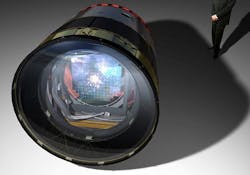3.2 billion pixel LSST camera project gets DOE "Critical Decision 1" approval
Menlo Park, CA--The Large Synoptic Survey Telescope (LSST) camera—a 3.2 billion-pixel digital camera designed by the SLAC National Accelerator Laboratory that will capture the widest, fastest, and deepest view of the night sky ever observed—received "Critical Decision 1" approval by the U.S. Department of Energy (DOE) to move into the next stage of the project. If all continues as planned, construction on the telescope will begin in 2014. Preliminary work has already started on LSST's 8.4 m primary mirror and its final site atop Cerro Pachón in northern Chile.
According to SLAC, The LSST will survey the entire visible sky every week, creating an unprecedented public archive of data--about 6 million gigabytes per year, the equivalent of shooting roughly 800,000 images with a regular eight-megapixel digital camera every night, but of much higher quality and scientific value. The data will help answer critical questions about the nature of dark energy and dark matter and aid studies of near-Earth asteroids, the structure of our galaxy, and many other areas of astronomy and fundamental physics.
Now that the LSST camera has passed Critical Decision 1, the project begins a detailed engineering design, schedule, and budget phase. While the DOE funds the design and construction of the camera, the full cost and logistics of the new telescope are being shared by the DOE and the National Science Foundation, as well as a large partnership of public and private organizations in the United States and abroad.
"With 189 sensors and over 3 tons of components that have to be packed into an extremely tight space, you can imagine this is a very complex instrument," said Nadine Kurita, the project manager for the LSST camera at SLAC.
"Not only should LSST revolutionize our understanding of the universe, its contents and the laws that govern its behavior, but it will also transform the way all of us, from kindergarteners to professional astrophysicists, use telescopes," said Tony Tyson, LSST director and a professor of physics at the University of California, Davis. "These are exciting times!"
SOURCE: SLAC; https://news.slac.stanford.edu/features/worlds-largest-digital-camera-project-passes-critical-milestone
About the Author

Gail Overton
Senior Editor (2004-2020)
Gail has more than 30 years of engineering, marketing, product management, and editorial experience in the photonics and optical communications industry. Before joining the staff at Laser Focus World in 2004, she held many product management and product marketing roles in the fiber-optics industry, most notably at Hughes (El Segundo, CA), GTE Labs (Waltham, MA), Corning (Corning, NY), Photon Kinetics (Beaverton, OR), and Newport Corporation (Irvine, CA). During her marketing career, Gail published articles in WDM Solutions and Sensors magazine and traveled internationally to conduct product and sales training. Gail received her BS degree in physics, with an emphasis in optics, from San Diego State University in San Diego, CA in May 1986.
